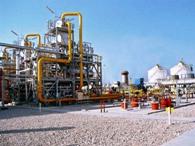 | « Back to article | Print this article |
 In the short run, ONGC and OIL should both reap a bonanza given the government hike, says Devangshu Datta.
In the short run, ONGC and OIL should both reap a bonanza given the government hike, says Devangshu Datta.
After the RIL-RNRL judgement, the government has raised the administered gas prices for fields controlled by ONGC and OIL.
The Supreme Court judgement in the Reliance Industries-Reliance Natural Resources (RIL-RNRL) case led to wider implications for the energy industry as a whole, quite apart from a massive impact on the respective Ambani empires.
The judgement confirmed the government's right to fix a price ($4.2/ mmbtu for a period of five years in this specific case) with respect to gas.
The government then took the logical and expected step of raising administered gas prices from fields controlled by ONGC and Oil India to roughly the same levels, up from the earlier $1.82 that it had set.
The government had, prior to the judgement, also set offtake quotas and priorities for the fertiliser industry (where natural gas is feedstock), the power sector (around 18,000 MW of Indian power capacity is gas-based) and the city gas distribution (CGD) network that is just getting off the ground.
Natural gas (NG) is globally-traded with the prices closely linked to crude oil. If crude oil rises, so does NG. However, there are considerable local variations due to technical difficulties in evacuation and transport. In India, gas from the British Gas-operated Panna, Mukta and Tapti fields sells at $5.73 while Cairn's Ravva field gas is priced at $5.5.
Currently, NG contracts are priced very close to $4.2 on the Nymex (New York Mercantile Exchange). Declines are expected in the near-term due to softening crude demand as the First World struggles with another bout of problems.
Over the past ten years, NG prices have been above $5, generally ranged between $6 and $10 with a high of over $13 in mid-2008 when crude oil peaked to $140-plus. On the other hand, through the 1990s, NG prices were well below $4, often below $2 - in that decade, crude was generally priced below $40 a barrel.
NG pricing is, therefore, about as volatile as crude. Unlike in the case of crude oil, India will possess a surplus of NG over domestic demand for a few years at least.
Hence, the government has more room to fiddle with pricing without causing direct damage to its own finances. In analogy with crude however, a policy of deliberate mispricing and subsidies is likely to set up all sorts of distortions.
The evacuation of KG-D6 is certainly profitable at $4.2 (it was profitable even at the proposed 44 per cent discount of the RNRL contract). There is nothing surprising about this.
The price of crude and of NG is driven by demand rather than cost of evacuation. Saudi Arabia and Kuwaiti oil for instance, would be profitable at $15 a barrel.
Given that it's being set for a five-year period, $4.2 is likely to look cheap sometime or the other. It is unlikely to look expensive unless the world economy transits into extended recession or into some phase that resembles the 1990s.
In any event, the government may have taken a commercially questionable decision in fixing prices for such a long period, instead of using some mechanism linked to market-fluctuations.
During that five-year period, a fair amount of new generation capacity, new fertiliser plants, CGD networks etc will all be built on the assumption of stable gas prices. Pipeline networks will also be set up to evacuate gas to new markets.
Those are enormous investments with positive externalities that would boost growth across the board.
However all these industries have a long gestation period and projects under planning now will come on-stream only two-three years later. Fairly early in their respective life-cycles, all the new plants will have to cater for price changes.
At some stage, the lobbying could get unpleasant. If prices rise, RIL and other exploration and production players will lobby for market-driven prices. Consumers will, on the other hand, lobby for market-linkages, if prices drop lower.
The energy industry makes a lot of decisions based on option-pricing and the world over, projects are taken up under various assumptions of price volatility. The problem with the current policy is that it isn't market-linked and so, many projects will not be.
There is talk of a gas pooling mechanism that will be linked to market prices but until such time as that is in place, it's difficult to make assumptions based on it.
In the short run, ONGC and OIL should both reap a bonanza given the government hike. RIL certainly won't hurt either. NTPC and other power producers with gas-based plants on the anvil will make business plans with this price as the baseline. We'll have to see what deal the Ambani brothers put together in renegotiation before making a call on the two groups.